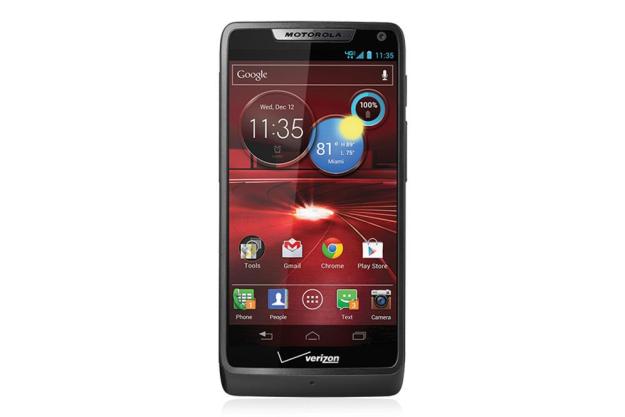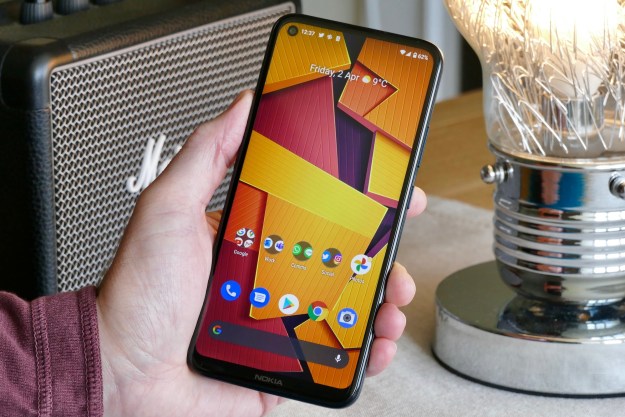
“The Razr M is one of the nicest handsets to hit Verizon in some time. It doesn’t have the flash of the iPhone 5 or Galaxy S3, but at half the price it’s more than worth the savings.”
- Feels great to hold
- Feisty Snapdragon S4 processor
- Clean version of Android 4.0
- Good battery life
- microSD
- Camera isn’t great
- UI can get jittery at times
- Screen isn’t quite HD
Motorola and Verizon couldn’t be closer. Motorola helped establish Verizon’s Android lineage with the original slide-out Droid back in 2009, and the carrier and phone maker have been bedfellows ever since. Combine the Droid name with Motorola’s rejuvenated obsession with stamping the name “Razr” on all of its phones, and you can mostly figure out why this phone is called the Droid Razr M. We don’t know exactly what the M stands for, but we’d like to think it stands for “modesty.” While competitors like Samsung and HTC continue to make larger and larger screens, Motorola has gone backward to find an old friend: the 4.3-inch screen. It was a good decision.
Design and feel
The Razr M does not pop off the shelf and scream “touch me” like a new iPhone might, but if you happen to really give it a look, you’re going to be impressed. Opting for a more universal 4.3-inch screen size that anyone can hold and use comfortably, Motorola has created one of its best-looking and most solid phones to date. The new Razr has an impressively thin bezel and measures only 8.3mm thick, not a lot thicker than the new iPhone 5 or original Droid Razr, which measure 7.6mm. But unlike the iPhone’s sharp edges and cut design, the Razr M is built to be held comfortably, with rounded edges all around.
The back of the phone has that familiar Droid Razr Kevlar pattern on it, but it feels like a more natural part of the design this time around, not just an advertising flourish. The flush camera is also a good thing for Motorola, which is known for its camera “bumps” on phones like the Razr.

Overall, the Droid Razr M is one of the better built and most comfortable handsets we’ve used.
Operating system
There’s something to be said for simplicity. Like Motorola’s decision to simplify the physical design of the Razr M, its software isn’t packing a ton of crazy new features. You get a mostly clean version of Android 4.0, with Android 4.1 supposedly on the way. It might have something to do with the fact that Google owns Motorola, but it has finally decided to embrace Android instead of frilling it up with “MotoBlur” designs that might as well be drawn with magic markers and charcoal.
The Razr M has onscreen navigation buttons, and (once again) keeps things simple. Motorola has added a really nice onscreen clock/weather/battery life widget that you can use if you wish, which even lets you swipe to flip its information over, displaying weather for other locations, a digital clock, or a button to access settings. It’s fun to fiddle with and a nice addition to the homescreen. Swiping to the left of the homescreen brings up another helpful new feature: a list of quick settings you can swap on and off, like GPS, mobile data, and Wi-Fi. This isn’t in other Android phones, but it should be. Instead of coming prestocked with half a dozen blank, customizable homescreens like most other Android devices, Motorola gives you the option to create them, as you need them. Not a bad feature.
The only issue we’ve had is a bit of slowness toward the end of the battery cycle, though that definitely isn’t a problem unique to Motorola. All Android phones tend to chug as they take their last swigs of delicious battery juice.
Overall, it’s refreshing to see a handset that isn’t afraid to use Android as is. It’s not a bad looking operating system and it exceeds iOS in many features, like notifications and mapping.
Hardware specifications
The Droid Razr M isn’t on the bleeding edge of technical prowess, but its close. It has a fast 1.5GHz dual-core Snapdragon S4 processor (same as the Galaxy S3), 1GB of RAM, 8GB of internal memory for storage, an 8-megapixel rear camera, a 0.3-megapixel front camera, and a 540 x 960 pixel Super AMOLED screen. We would have loved to see a slightly higher resolution, but the screen is definitely serviceable. We like the dark blacks that AMOLED screens are capable of. Unfortunately, at lower resolutions like this, visible black subpixels can also be seen, giving edges of icons a grainy appearance. You’ll quickly get used to this deficiency, but compared to a Galaxy S3 or iPhone 5 screen, the Razr M will look a little pixelated upon examination.
If you’re looking for ports and places to stick things, the Razr M has a Micro USB port for charging, a microSD slot, and a headphone jack up top. NFC, DLNA, Wi-Fi, Bluetooth 4.0, GPS, and 4G LTE connectivity over Verizon’s network are also included.
We’ve made a number of calls and sent many texts on the Razr M and haven’t noticed any nagging issues with quality or reception. Connectivity to Verizon’s LTE network is also strong. We’ve been getting an average of 6-12 Megabits per second download and upload speeds here in Manhattan, New York.
Battery life has been good, but not as good as Motorola advertises. It’s claiming around 20 hours of talk time. We just aren’t seeing this, but on moderate use, we were able to get almost two days of battery life without a charge. If you’re downloading or streaming a lot of audio or video, expect your battery life to drop. We are happy, however, to note that the Razr appears to hold a charge much better on idle than recent Motorola phones like the Photon Q and Atrix HD. If you’re looking for a number, this has a 2,000mAh battery.
Camera
The performance of the Razr M’s 8-megapixel rear camera feels similar to the Atrix and Photon Q. Motorola is actively working on improving its camera, but it still isn’t as good as competitors like HTC, Samsung, or Apple. Motorola just hasn’t caught up.

Like the Q and Atrix, the Razr M was tough to focus in dark situations, outdoor shots still lack some vibrancy, the lens isn’t as wide (shots have a “zoomed” appearance), and most shots lack fine detail. You can shoot good pictures on the Razr M, but it doesn’t help you as much as it should. If you’re a camera freak, do not buy the Razr M.
Conclusion
The Razr M is one of the nicest handsets to hit Verizon in some time. It doesn’t have the flash of the iPhone 5 or Galaxy S3, but at half the price — $100 on a two-year contract – it’s more than worth the savings. The only weak points here are the camera and the lower-resolution screen, but the great build quality and feel of the Razr M combined with its moderately-sized screen should make it a top pick for those who want a great phone at a good price – but also don’t have hands the size of Shaquille O’Neal’s. If you’re a Verizon subscriber (or on any carrier that has the Razr M), we highly recommend you try it out. It feels nice!
Highs
- Feels great to hold
- Feisty Snapdragon S4 processor
- Clean version of Android 4.0
- Good battery life
- microSD
Lows
- Camera isn’t great
- UI can get jittery at times
- Screen isn’t quite HD
Editors' Recommendations
- The best Motorola phones in 2024: which one should you buy?
- The best prepaid phone plans in 2023: the 6 best ones
- Motorola just launched 3 new Android phones, and they look incredible
- A new Motorola Razr is coming soon, and it could be the best one yet
- Best mobile hotspots for travel in 2022













